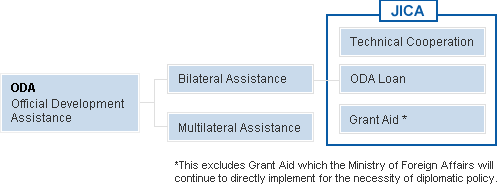A variety of organizations and groups, including governments as well as international organizations, non-governmental organizations (NGOs) and private companies, carry out financial assistance to developing countries for socioeconomic development. ODA, as defined by the Development Assistance Committee (DAC) of the Organization for Economic Co-operation and Development (OECD), must meet the following three requirements:
- It should be undertaken by governments or government agencies
- The main objective is the promotion of economic development and welfare in developing countries
- Regarding financial cooperation, the grant element of its terms and conditions must meet the standards set by countries and institutions.
Note: The grant element measures the concessionality or "softness" of financial terms of a loan. The lower the interest rate and the longer the maturity period, the higher the grant element, which means it is more beneficial to the borrower. The grant element for a grant is 100%.
Regarding the standards set of Grant element, prior to 2017, it was 25% or higher for all countries and institutions. After 2018, it is 45% or higher for low-income coutries (LDCs and other LICs), 15% or higher for high-income countries, 10% or higher for multi-institution.
ODA is broadly divided into bilateral aid, in which assistance is given directly to developing countries, and multilateral aid, which is provided through international organizations. JICA provides bilateral aid in the form of Technical Cooperation, Japanese ODA Loans and Grant Aid.





scroll